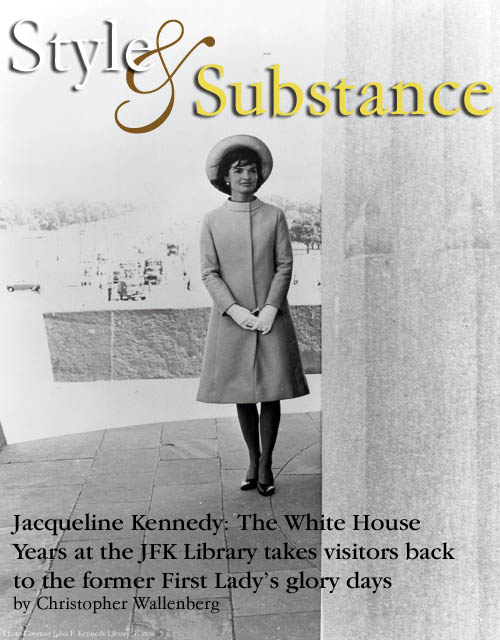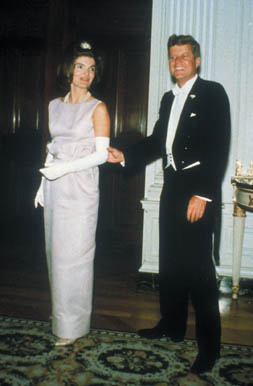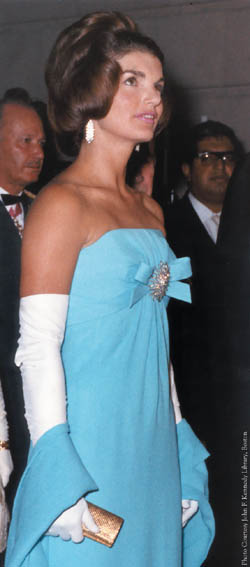date published: September 17, 2001

Although Jacqueline Kennedy Onassis was one of this country’s great fashion trendsetters, she is also one of America’s great political and historic icons. That’s why officials at the John F. Kennedy Library and Museum insisted that the exhibit they were planning with New York’s Metropolitan Museum of Art, which focuses on Kennedy’s wardrobe from her years as first lady, delve into her political and historic contributions as well.
“It was very important, from our point of view, that audiences be provided with a sense of Jacqueline Kennedy’s substance as well as her style,” says Kennedy Library curator Frank Rigg, who collaborated with the team at the Costume Institute at New York’s august Metropolitan Museum of Art to assemble the landmark exhibit, Jacqueline Kennedy: The White House Years: Selections from the John F. Kennedy Library and Museum. The show runs from September 15 through February 28 at Boston’s Kennedy Library, following its premiere last spring at the Met in New York. In addition to the more than 80 original outfits that Mrs. Kennedy wore to state events and visits around the world, “The White House Years” showcases some 200 documents and objects associated with her important work on the restoration of the White House, historic preservation and the arts.
“It was an unusual thing for the Metropolitan Museum to mount an exhibition that worked in so much history, as their focus has always been art. But we were pretty insistent and they were very receptive,” says Rigg.
The exhibit, though, is primarily concerned with the first lady’s iconic style and centers around the elegant costumes she wore to state events at the White House, most of which have never before been displayed. This wardrobe was an integral part of the impenetrable aura—the vaunted “Camelot mystique”—that glowed around her during her years as first lady.
 The Happy Couple—Jackie and President Kennedy attend a White House dinner in April of 1963. |
Curated by one of Vogue’s European fashion editors Hamish Bowles, “The White House Years” features the celebrated pillbox hat and fawn coat Kennedy wore to her husband’s inauguration on the steps of the Capitol in 1961; her regal ivory satin gown from the pre-Inaugural gala; the beaded evening gown that enchanted Soviet premier Nikita Khrushchev in Vienna in 1961; and the red wool day suit she donned for her famous televised tour of the White House on Valentine’s Day in 1962.
Many of these dresses were created by some of the world’s top designers, including Oleg Cassini, Herbert de Givenchy, Christian Dior and Pierre Cardin. Most of them boast the signature Jackie Look: simple, sometimes asymmetrical lines; solid, striking colors; and an eye-catching yet spartan use of buttons and other adornments.
The first lady’s style reflected the bold, energetic and optimistic spirit of the young Kennedy administration. Bowles says Jackie’s wardrobe was to be a “stylish visual metaphor” for the sophisticated, cultured hopes of the new White House. She and the designers also tailored her clothing to reflect the heritage of each place that she visited. She wore a pink dress in India, aqua blue in Greece, a reverent black dress to the Vatican, and a red wool day suit when she met with the Royal Canadian Mounted Police.
Although the exhibit is focused almost squarely on Mrs. Kennedy’s wardrobe, historical context is paramount to understanding the woman behind the fashionable costumes.
By combining the Met’s expertise in costume design (not to mention
its vast financial resources) and the Kennedy Library’s encyclopedic knowledge of the Kennedys’ time in the White House, the show is given a depth it might not have had otherwise. Supported by the vast treasures of the Library’s permanent collection, the exhibit allows audiences to see how the story of Jacqueline Kennedy’s role as first lady fits into the larger picture of who she was as a person.
Explains Rigg, “We hope that in illustrating some of her accomplishments—restoring the White House, establishing the White House collections of furniture and art, publishing the White House guest book and establishing the White House Library—much of which is portrayed through
 Blue Lady—The First Lady shines at a reception in Mexico, 1962. |
her own hand-written accounts, people will get a sense of how knowledgeable she was, how involved in a very detailed way she was in all of these projects. She had a great skill in getting things done and being able to persuade people to help her get them done. She was a very remarkable person who, I think, many of us had no sense of because she was so private.”
For almost 20 years, most of the former first lady’s White House wardrobe has been locked away in a dark, cloistered room in the Kennedy Library where it wouldn’t suffer the damaging effects of overexposure to light. Mrs. Kennedy donated much of the collection to the Library in the early 1980s. Her children, Caroline Kennedy Schlossberg and the late John F. Kennedy, Jr., then bequeathed a large amount of written and other material from their mother’s estate after her death in 1994.
A few years later, interest began to build in creating an exhibit based around her White House wardrobe. Rigg had hoped to mount one at the Kennedy Library before the Met approached him. But “she always wanted the focus to be on President Kennedy and she was always reminding us of that,” explains Rigg of why the wardrobe has not been displayed before. Enough time, however, had finally passed. And with the blessing of Caroline Kennedy Schlossberg, the Kennedy Library and the Met began planning the show.
The exhibit, however, has not escaped contention. Controversy erupted at the New York opening last spring when Oleg Cassini, the noted fashion designer who created a majority of the dresses featured in the exhibition, complained that curator Bowles did not give him enough credit for creating Jackie’s image. “I think it’s very unfortunate that Mr. Cassini made an issue out of it,” responds Rigg. “All he really needed to do was bask in the credit of having designed most of these costumes...He did design the majority, but there are also a number of costumes that others designed.”
Any exhibition focusing on the iconic former first lady was bound to draw a great deal of attention. The public—both here and abroad—has long been intrigued by the elusive Jackie and the allure of her self-fashioned “Camelot.” Her beauty, wit, spirit and style, as well as the courage and dignity she showed leading a nation through the turbulent aftermath of her husband’s assassination, created a legion of loyal admirers. “She was very much a part of America’s coming of age as a world leader,” says Rigg. “America had a bit of an inferiority complex when it came to our culture and heritage. We looked to Europe for leadership in those areas. But she was constantly reminding us to take pride in our own traditions. She gave Americans a different vision of ourselves.”
And now Rigg hopes “The White House Years” can provide audiences with a different, more intimate view of the elusive, enchanting figure that was Jacqueline Kennedy.

back to homepage